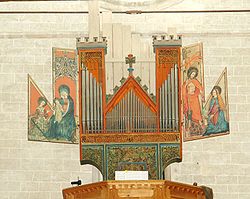Organ of the Basilique de Valère
| Organ of the Basilique de Valère | |
|---|---|

|
|
| General | |
| place | Basilique de Valere |
| Organ builder | Unknown |
| Construction year | 1435 |
| Last renovation / restoration | 1954 by Kuhn |
| Technical specifications | |
| Number of registers | 8th |
| Number of rows of pipes | 10 |
| Number of manuals | 1 |
| Wind chest | Slider drawer |
| Tone tract | mechanically |
| Register action | mechanically |
The organ of the Basilique de Valère in Sion , Switzerland , is counted among the oldest playable organs in the world alongside the instruments in Rysum , Kiedrich , Ostönnen and the Epistel organ in San Petronio in Bologna .
The essentially late Gothic swallow's nest organ probably dates back to 1435. Today the instrument has eight registers . The case from 1435 has been preserved in its original form, and two stops from the original organ and two parts have been preserved. The current tonal condition is largely due to the extension work (1686–1688) by Christoph Aebis.
Building history
Due to the time the case was painted, 1435 is considered to be the year the organ was built. The result of the investigation with the radiocarbon method also allows this year of origin. The organ probably originally had a circumference of 2 ha and consisted of a block with up to 18 pipes per tone.
The location of the organ in the so-called swallow's nest on the west wall seems to be original, even if its current shape was created by Aebi for the renovation. The case, together with the double doors painted by Peter Maggenberg and the Gothic tracery, has been preserved in the original. However, due to the enlarged wind chest , it is no longer possible to close the doors. Therefore, the outer sides of the wings were removed, they are exhibited separately.
The metal pipe for the sounds Hf 2 of the Principal 8 ', the octave 2', the bottom minor 1 1 / 3 'and 1'-series are obviously the mixture obtained from the Gothic period. They were cast from lead on sand. The front of the prospect pipe is coated with tin.
From 1686 to 1688, Christoph Aebi converted the organ into a baroque instrument and expanded it. In favor of the current scope he renewed the keyboards and transferred to the Gothic work block in an instrument with mechanical register contracture ( sliderchest ). At the same time the wind chests and the action mechanism were replaced. Aebi added four new registers to the organ and reused some of the old pipes. But he reworked them, and they are still preserved in this form today.
The pedal , which was only attached to the late Gothic instrument, was also rebuilt by Aebi, but it was probably not until the 18th century that it was extended independently with two nine pipes. Up to the last major intervention in the organ in 1827, five repairs are documented. After that, the instrument fell into disrepair.
After the organ continued to degenerate at the beginning of the 20th century, a restoration was carried out by Orgelbau Kuhn (Männedorf) in 1954, which was careful for the time .
Disposition since 1688
|
|
||||||||||||||||||||||
Remarks
- ↑ C – B made of wood behind the housing, from H made of metal in the brochure.
- ↑ C – F from Coppel 4 ′ (common use of the pipes), from G made of metal.
- ↑ Covered, made of walnut; Lid board, proposal and pipe stand from one piece.
- ↑ C – F as 1 1 ⁄ 3 ′.
- ↑ From dis² as 2 2 ⁄ 3 ′.
-
↑ The composition of the mixture is very unusual:
C – b 0 : 1' + 1 ⁄ 2 ′ h 0 - h 1 : 1' + 4 ⁄ 5 ′ from c 2 : 2 ′ + 1 3 ⁄ 5 ′. - ↑ Covered wooden pipes on their own drawer behind the case.
Technical specifications
- 8 registers
-
Action :
- Tone action: mechanical
- Stop action: mechanical
- Wind supply:
- Two wedge bellows
-
Mood :
- High quarter tone above a 1 = 440 Hz
- Mid-tone temperature (since summer 2019, previously the same temperature
literature
- Friedrich Jakob u. a .: The Valeria organ . vdf-Hochschulverlag, Zurich 1991, ISBN 3-7281-1666-1 ( limited preview in Google book search).
Web links
- die-orgelseite.de
- Organ building Kuhn
- orgues-et-vitraux.ch (French)
- orgelsite.nl (Dutch)
- ↑ Organ Database: Organ in Sion, Basilique de Valère , accessed on August 24, 2020.
